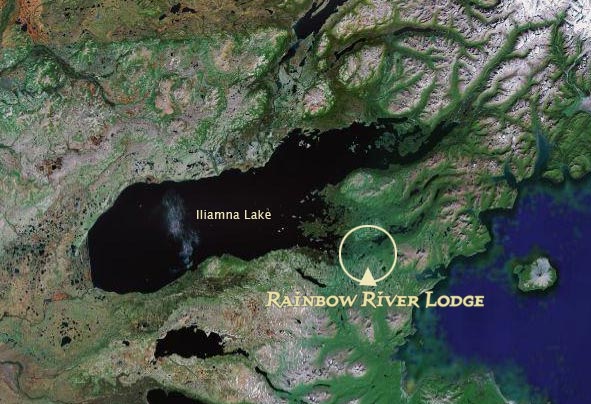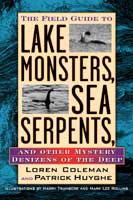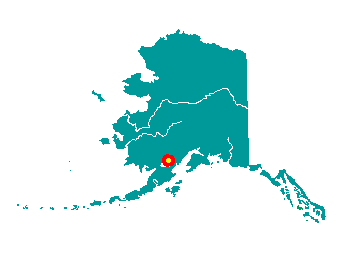Is Illie A Sleeper Shark?
Posted by: Loren Coleman on May 8th, 2012

The alleged lake monster in Alaska’s Lake Iliamna is sometimes called “Illie.”
Now…
one scientist thinks Illie may turn out to be a variety of a sleeper shark.
“Certainly the size and the shape and the color seems to match a lot of the descriptions,” said Bruce Wright, a biologist and senior scientist with the Aleutian Pribilof Islands Association in Anchorage, Alaska.
If a 20-foot sleeper shark lives in the huge Alaskan lake, it could account for many of the reports made by people who see something they can’t identify break the surface of the water.
“What confuses me is this [habit of the creature] breaking the surface. I don’t know if sleeper sharks do that,” Wright, author of “Alaska’s Great White Sharks,” told The Huffington Post.
“They do use the surface waters but tend to stay down deep during the day and come up at night,” he added.

This 2000 image shows biologist Bruce Wright in salt waters in southeast Alaska with a small Pacific sleeper shark that was caught on a research cruise. He believes much bigger versions of this shark group could be the true identity of Scotland’s Loch Ness Monster and Alaska’s Lake Iliamna creature known as Illie.

In my The Field Guide to Lake Monsters, Sea Serpents and Other Mystery Denizens of the Deep. (NY: Tarcher-Penguin, 2003, coauthored with Patrick Huyghe), we placed the Lake Illiamna Monster in the “Giant Shark” category.

I wonder if the newly highlighted Canadian biologist Bruce Wright is related to the late Bruce S. Wright, Ph. D., the wildlife director from New Brunswick who authored Ghost of North America, about the sightings and possible existence of the Eastern Panther?

About Loren Coleman
Loren Coleman is one of the world’s leading cryptozoologists, some say “the” leading living cryptozoologist. Certainly, he is acknowledged as the current living American researcher and writer who has most popularized cryptozoology in the late 20th and early 21st centuries.
Starting his fieldwork and investigations in 1960, after traveling and trekking extensively in pursuit of cryptozoological mysteries, Coleman began writing to share his experiences in 1969. An honorary member of Ivan T. Sanderson’s Society for the Investigation of the Unexplained in the 1970s, Coleman has been bestowed with similar honorary memberships of the North Idaho College Cryptozoology Club in 1983, and in subsequent years, that of the British Columbia Scientific Cryptozoology Club, CryptoSafari International, and other international organizations. He was also a Life Member and Benefactor of the International Society of Cryptozoology (now-defunct).
Loren Coleman’s daily blog, as a member of the Cryptomundo Team, served as an ongoing avenue of communication for the ever-growing body of cryptozoo news from 2005 through 2013. He returned as an infrequent contributor beginning Halloween week of 2015.
Coleman is the founder in 2003, and current director of the International Cryptozoology Museum in Portland, Maine.










More likely a large Sturgeon which, incidentally, has a shark-like profile and has been proven to reach 18ft. in length.
Also, note that very few sharks are able to survive in freshwater environments for anything other than short periods of time. Why? The high concentration of salt in their bodies causes them to absorb excess fluid when placed in fresh water, eventually killing them.
However, Bull Sharks are an exception; so, there is a precedent… Then again, everything I’ve read (granted, not a whole lot!) indicates Sleeper Sharks are a dedicated deep-water ocean species.
So, one big question: Can Sleeper Sharks live in, i.e. not just temporarily tolerate, a freshwater environment?
If not, then I think we need to look elsewhere re Illie’s identity…
I think we’ll find something in Lake Iliamna: it’s one of the few large cryptids I’d bet my own money on. (I cannot, by the way, figure out where the term “Illie” originated – maybe in the media. A few years ago I talked to several people at the lake via phone or internet who had an interest in the subject and none of them had heard the term.) Anyway, I do believe sturgeon are much more likely, since we don’t have any evidence sleeper sharks adapt to fresh water. What I wonder about is whether this population has been isolated so many thousand years it might warrant its won taxonomic label. One of these days someone will catch, snag, or run over a specimen, and we will find out.
A river connects Lake Illiamna to Bristol Bay and the Bering Sea. Sturgeon were known from that area until overfishing wiped the population out about 75 years ago. Maybe not. My money is with Matt. If it exists, it’s some type of sturgeon.
Jeremy Wade thinks it is a sturgeon. I trust his knowledge over anyone else on this matter.
As far as I know, only Bullsharks and their relatives like the Zambezi sharks can live in fresh water. Most sharks will just have their swim bladders explode if they stay in heavily deluded brackish water. I suppose it depends on how fresh the lake is. Greenland Sharks, which are related, swim in the estuary of the Saint Lawrence River. Honestly there isn’t enough known about Atlantic or Pacific Sleeper sharks to judge here.
My money is on Sturgeon, but it is not impossible a bull shark who adapted for colder water could live there.
Here is a great link to the Greenland Shark, which is an Atlantic Sleeper Shark, and larger than the Pacific Sleeper Shark. It would be safe to assume they have similar behaviors and the same biology.
In theory scientists speculate it is possible for them to stand brackish waters.
I’ve always thought Illie could be one of two, fish species. I believe it is either a Greenland Shark, which in a Monsterquest episode a few years back, has been proven to survive fresh water. The other possible culprit could be a Beluga Sturgeon which grows to immense proportions and are highly endangered, because of their prized eggs, used for caviar. Neither Greenland Sharks or Beluga Sturgeon have been proven to live in the lake, but both have similar profiles and both could reach the gigantic sizes that witnesses have reported. It’s too bad that the lake is in such a remote region, because with the right kind of boat and fishing equiptment, the identity of this fish could easily be uncovered.
The recent Lake Champlain video looks pretty ‘sharky’.
Redrose999, bullsharks and Zambesi-sharks are more or less the same, as the Zambesi-shark is a subspecies of the bullshark. There are also some other subspecies of the bullshark which regularly enter freshwater like those in Nicaragua or the Ganges river. But they have to go back sea for reproduction. There are also some few little known freshwater sharks like the Ganges-shark (which is not identical to the Ganges-bullshark) and other members of the genus Glyphis.
Salinity has no relation to the swim bladders of shark – simply because cartilaginous fish like sharks don´t have a swim bladder at all. The reasons why most of them can not survive in freshwater for long time have other physiological reasons.
CryptidCrazy: It´s a big difference if a fish enters the mouth of a river near the sea, where the salinity is still comparable high, or a lake with freshwater conditions. Belugas are only recorded from Eurasia, but not from the north american continent.
Sordes: “Belugas are only recorded from Eurasia, but not from the north american continent.”
If by that you mean belugas do not occur in Alaskan waters, someone needs to tell the big pod of them my wife and I saw in Cook Inlet while driving to Anchorage from the Kenai Peninsula in 1991. No question what they were; might have been over 100.
Range description on arkive.org:
“Beluga whales are found in Arctic waters around northern Russia, North America, Greenland and the Norwegian archipelago of Svalbard (3). “
And now I have to note the post to which Sordes was responding, which appears to be referring to the beluga sturgeon, a fish.
Of course there are North American sturgeon species, too.
Just because Beluga Sturgeons are only recorded in Eurasia, doesn’t necessarily mean there isn’t a population in this particular Alaskan lake. The truth is, very little is known about Lake Iliamna. It’s very deep, very cold and very remote. I’m not saying for sure, that it’s a Beluga Sturgeon. I’m just saying it’s not out of the realm of possibility. From the eyewitness descriptions I have seen, it seems like a Beluga could be a real possibility. I’ll admit that it’s probably a longshot, that this creature is a shark, but it’s not impossible. As for Sturgeons, the most commonly known ones in North America are the Lake Sturgeon and the White Sturgeon. Lake Sturgeons would be way too small to be considered in this case and from everything I have read about Illie, even a giant White Sturgeon might be too small for consideration. Rarely do they reach lengths of 15′, but some eyewitnesses, report Illie to be upward of 25′-30′ long.
White sturgeons can reach quite big sizes, and they are not even that much smaller than Beluga sturgeons at all. In overall proportions they are lesser bulky and do not reach the massive weight of Huso huso. But still white sturgeons are by far the most plausible explanation for giant fish in this area.
So there is a fish which is native to north american streams and which can potentially grow to lengths (but not weights) similar to Beluga sturgeons, so there is really no need about overconscientious speculations that there could be Beluga sturgeons at North America or Canada as well (without any recorded specimens from the past).
The sizes given by eyewitness are not really very helpful, as people are extremely prone to overestimate (and exagerate) things they have seen in the water.
Overestimating by nearly double, is quite a stretch, Sordes. Like I said, White Sturgeons only grow to about 15 ft, while the largest Beluga on record is 24′ long. People in Alaska are used to seeing whales and other large creatures, so I doubt they are overestimating that much, when they claim that the fish is 25′ to 30′ feet long.